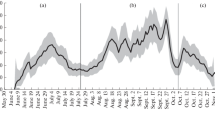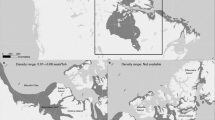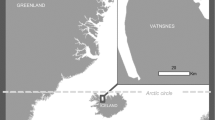Abstract
Harbour seals (Phoca vitulina) occur in the Arctic but little is known of their population abundance and natural history. In western Hudson Bay, they occur at lower numbers relative to ringed seals (Pusa hispida) and their distribution is largely unknown. However, a reduction in the duration of periods of ice cover in Hudson Bay may be shifting the habitat suitability of the region towards one that favours harbour seals. Harbour seal counts from a known haul-out site at the upstream extent of the Churchill River estuary, located in northern Manitoba, were examined in relation to sea ice conditions in western Hudson Bay. The Churchill River estuary haul-out site was observed directly or remotely (via GigaPan™ photos) during the open-water seasons in 1996, 1999, 2000, and 2005, and from 2014 to 2016. We documented an increase in abundance over the study period; the maximum number of harbour seals observed hauled out at one time was 142 in 2016, compared to a maximum of 32 observed during monitoring activities conducted between 1996 and 2005. In addition, newly born harbour seal pups were observed at the haul-out site during the latter study years, an occurrence not observed from 1996 to 2005. We suggest that an increase in the abundance of harbour seals in Hudson Bay and potentially the entire Arctic may be observed if climate change related reductions in the duration of ice cover continue.





Similar content being viewed by others
References
Bailey H, Hammond PS, Thompson PM (2014) Modelling harbour seal habitat by combining data from multiple tracking systems. J Exp Mar Biol Ecol 450:30–39
Bajzak CE, Bernhardt W, Mosnier A, Hammill MO, Stirling I (2013) Habitat use by harbour seals (Phoca vitulina) in a seasonally ice-covered region, the western Hudson Bay. Polar Biol 36:477–491
Bartholomew GA (1970) A model for the evolution of pinniped polygyny. Evolution 24:546–559
Beck B, Smith TG, Mansfield AW (1970) Occurrence of the harbour seal, Phoca vitulina, Linnaeus in the Thlewiaza River, N.W.T. Can Field-Nat 84:297–300
Bernhardt WJ (2006) Lower Churchill River Water level enhancement weir project post project monitoring—an assessment of seal responses to operation of the project: a synthesis of monitoring from 1996 to 2005. A report prepared for Manitoba Hydro by North/South Consultants Inc. pp 110
Bigg MA (1969) Clines in the pupping season of the harbour seal, Phoca vitulina. J Fish Board Can 26:449–455
Boulva J, McLaren IA (1979) Biology of the harbor seal, Phoca vitulina, in eastern Canada. J Fish Res Board Can 200:1–24
Cameron ME, Metcalfe TL, Metcalfe CD, Macdonald CR (1997) Persistent organochlorine compounds in the blubber of ringed seals (Phoca hispida) from the Belcher Islands, Northwest Territories, Canada. Mar Env Res 43:99–116
Chambellant M, Stirling I, Gough WA, Ferguson SH (2012) Temporal variations in Hudson Bay ringed seal (Phoca hispida) life-history parameters in relation to environment. J Mamm 93:267–281
COSEWIC (2007) COSEWIC assessment and update status report on the harbour seal Atlantic and Eastern Arctic subspecies Phoca vitulina concolor and Lacs des Loups Marins subspecies Phoca vitulina mellonae in Canada. Committee on the Status of Endangered Wildlife in Canada, pp 40
Cowles JD, Henson SM, Hayward JL (2013) A method for predicting harbour seal (Phoca vitulina) haulout and monitoring long-term population trends without telemetry. Nat Resour Model 26:605–627
Derocher AE, Lunn NJ, Stirling I (2004) Polar bears in a warming climate. Integr Comp Biol 44:163–176
Derocher AE, Aars J, Amstrup SC, Cutting A, Lunn NJ, Molnár PK, Obbard ME, Stirling I, Thiemann GW, Vongraven D, Wiig Ø, York G (2013) Rapid ecosystem change and polar bear conservation. Conserv Lett 6:368–375
Dyke AS, Hooper J, Savelle JM (1996) A history of sea ice in the Canadian Arctic Archipelago based on postglacial remains of the bowhead whale (Balaena mysticetus). Arctic 49:235–255
Elgar MA (1989) Predator vigilance and group size in mammals and birds: a critical review of the empirical evidence. Biol Rev 64:13–33
Ferguson SH, Stirling I, McLoughlin P (2005) Climate change and ringed seal (Phoca hispida) recruitment in Hudson Bay. Mar Mamm Sci 21:121–135
Ferguson SH, Young BG, Yurkowski DJ, Anderson R, Willing C, Nielsen O (2016) Demographic, ecological and physiological responses of ringed seals to an abrupt decline in sea ice availability. PeerJ 5:e2957
Ferguson SH, Young BG, Yurkowski DJ, Anderson R, Willing C, Nielsen O (2017) Demographic, ecological, and physiological responses of ringed seals to an abrupt decline in sea ice availability. Peer J 5:e2957
Gagon AS, Gough WA (2005) Trends in the dates of ice freeze-up and break-up over Hudson Bay, Canada. Arctic 58:370–382
Gough WA, Wolfe E (2001) Climate change scenarios for Hudson Bay, Canada, from general circulation models. Arctic 54:142–148
Hammill MO (2013) Effects of climate warming on Arctic marine mammals in Hudson Bay: living on the edge? In: Mueter FJ, Dickson DMS, Huntington HP, Irvine JR, Logerwell EA, MacLean SA, Quakenbush LT, Rosa C (eds) Responses of Arctic marine ecosystems to climate change. University of Alaska Fairbanks, Alaska Sea Grant, pp 21–28
Härkönen T, Harding K (2001) Spatial structure of harbour seal populations and the implications thereof. Can J Zool 79:2115–2127
Harwood LA, Smith TG, Melling H (2000) Variation in reproduction and body condition of the ringed seal (Phoca hispida) in western Prince Albert Sound, NT, Canada, as assessed through a harvest-based sampling program. Arctic 53:422–431
Harwood LA, Smith TG, Melling H, Alikamik J, Kingsley MCS (2012) Ringed seals and sea ice in Canada's western Arctic: harvest-based monitoring 1992–2011. Arctic 65:377–390
Hedeholm R, Grønkjær P, Rysgaard S (2011) Energy content and fecundity of capelin (Mallotus villosus) along a 1,500-km latitudinal gradient. Mar Biol 158:1319–1330
Higdon JW, Ferguson SH (2009) Loss of Arctic sea ice causing punctuated change in sightings of killer whales (Orcinus orca) over the past century. Ecol Appl 19:1365–1375
Hochheim KP, Lukovich JV, Barber DG (2011) Atmospheric forcing of sea ice in Hudson Bay during the spring period, 1980–2005. J Mar Syst 88:476–487
Holst M, Stirling I, Calvert W (1999) Age structure and reproductive rates of ringed seals (Phoca hispida) on the northwestern coast of Hudson Bay in 1991 and 1992. Mar Mamm Sci 15:1357–1364
Iacozza J, Ferguson S (2014) Spatio-temporal variability of snow over sea ice in western Hudson Bay, with reference to ringed seal pup survival. Polar Biol 37:817–832
Kovacs KM, Lavigne DM (1986) Maternal investment and neonatal growth in phocid seals. J Anim Ecol 55:1035–1051
Kovacs KM, Lydersen C, Overland JE, Moore SE (2011) Impacts of changing sea-ice conditions on Arctic marine mammals. Mar Biodivers 41:181–194
Laidre KL, Stern H, Kovacs KM, Lowry L, Moore SE, Regehr EV et al (2015) Arctic marine mammal population status, sea ice habitat loss, and conservation recommendations for the 21st century. Conserv Biol 29:724–737
Lindsay R, Schweiger A (2015) Arctic sea ice thickness loss determined using subsurface, aircraft, and satellite observations. Cryosphere 9:269–283
London JM, ver Hoef JM, Jeffries SJ, London JM, Lance MM, Boveng BL (2012) Haul-out behavior of harbour seals (Phoca vitulina) in Hood Canal, Washington. PLoS ONE 7:e381080. https://doi.org/10.1371/journal.pone.0038180
Loseto LL, Richard P, Stern GA, Orr J, Ferguson SH (2006) Segregation of Beaufort Sea beluga whales during the open-water season. Can J Zool 84:1743–1751
Lowry L (2016) Phoca vitulina. The IUCN Red list of threatened species 2016: e.T17013A45229114
Lunn NJ, Servanty S, Regehr EV, Converse SJ, Richardson E, Stirling I (2015) Demography and population status of polar bears in Western Hudson Bay, Canada. Environment Canada Research Report, Edmonton
Mansfield AW (1967) Distribution of the harbor seal, Phoca vitulina Linnaeus, in Canadian arctic waters. J Mamm 48:249–257
Merkel B, Lydersen C, Yoccoz NG, Kovacs KM (2013) The world’s northernmost harbour seal population—how many are there? PLoS ONE 8:e67576. https://doi.org/10.1371/journal.pone.0067576
Obbard ME, Cattet MRL, Moody T, Walton L, Potter D, Inglis J, Chenier C (2006) Temporal trends in the body condition of Southern Hudson Bay polar bears. Clim Chang Res Inf Note 3:1–8
Obbard ME, Cattet MRL, Howe EJ, Middel KR, Newton EJ, Kolenosky GB, Abraham KF, Greenwood CJ (2016) Trends in body condition of polar bears (Ursus maritimus) from the Southern Hudson Bay subpopulation in relation to changes in sea ice. Arct Sci 2:15–32
Paulbitski PA (1974) Pinnipeds observed in rivers of northern California. Calif Fish Game 60:48–49
Petersen SD, Hainstock M, Wilson PJ (2010) Population genetics of Hudson Bay marine mammals: current knowledge and future risks. In: Ferguson SH, Loseto LL, Mallory ML (eds) A little less Arctic: top predators in the world’s largest northern inland sea. Springer, Hudson Bay, pp 237–265
Post E, Bhatt US, Bitz CM, Brodie JF, Fulton TL, Heeblewhite M, Kerby J, Kutz SJ, Stirling I, Walker DA (2013) Ecological consequences of sea-ice decline. Science 341:519–524
Regehr EV, Lunn NJ, Amstrup SC, Stirling I (2007) Effects of earlier sea ice breakup on survival and population size of polar bears in Western Hudson Bay. J Wildl Manag 71:2673–2683
Robillard A, Lesage V, Hammill MO (2005) Distribution and abundance of harbour seals (Phoca vitulina concolor) and grey seals (Halichoerus grypus) in the Estuary and Gulf of St. Lawrence, 1994–2001. Can Tech Rep Fish Aquat Sci 2613:1–152
Rode KD, Regehr EV, Douglas DC, Durner G, Derocher AE, Thiemann GW, Budge SM (2014) Variation in the response of an Arctic top predator experiencing habitat loss: feeding and reproductive ecology of two polar bear populations. Glob Chang Biol 20:76–88
Roffe TJ, Mate BR (1984) Abundances and feeding habits of pinnipeds in the Rogue River, Oregon. J Wildl Manag 48:1262–1274
Sciullo L, Thiemann GW, Lunn NJ, Ferguson SH (2017) Intraspecific and temporal variability in the diet composition of female polar bears in a seasonal sea ice regime. Arct Sci 3:672–688
Smith RJ, Hobson KA, Koopman HN, Lavigne DM (1996) Distinguishing between populations of fresh- and salt-water harbour seals (Phoca vitulina) using stable-isotope ratios and fatty acid profiles. Can J Fish Aquat Sci 53:272–279
Stewart BS (1984) Diurnal hauling patterns of harbor seals at San Miguel Island, California. J Wildl Manag 48:1459–1461
Stewart DB, Barber DG (2010) The ocean–sea ice–atmosphere system of the Hudson Bay complex. In: Ferguson SH, Loseto LL, Mallory ML (eds) A little less Arctic: top predators in the world’s largest northern inland sea. Springer, Hudson Bay, pp 1–28
Stewart REA, Hamilton JW (2013) Estimating total allowable removals for walrus (Odobenus rosmarus rosmarus) in Nunavut using the potential biological removal approach. DFO Can Sci Advis Sec Res Doc 2013/031
Stirling I, Derocher AE (2012) Effects of climate warming on polar bears: a review of the evidence. Glob Chang Biol 18:2694–2706
Stirling I, Smith TG (2004) Implications of warm temperatures and an unusual rain event for the survival of ringed seals on the Coast of southeastern Baffin Island. Arctic 57:59–67
Stirling I, Lunn NJ, Iacozza J (1999) Long-term trends in the population ecology of polar bears in western Hudson Bay in relation to climatic change. Arctic 52:294–306
Stirling I, Lunn NJ, Iacozza J, Elliot C, Obbard M (2004) Polar bear distribution and abundance on the southwestern Hudson Bay coast during open-water season, in relation to population trends and annual ice patterns. Arctic 57:15–26
Sundqvist L, Harkonen T, Svensson CJ, Harding KC (2012) Linking climate trends to population dynamics in the Baltic ringed seal: impacts of historical and future winter temperatures. Ambio 41:865–872
Terhune JM, Almon M (1983) Variability of harbour seal numbers on haul-out sites. Aquat Mamm 10:71–78
Thiemann GW, Lunn NJ, Richardson ES, Andriashek DS (2011) Temporal change in the morphometry-body mass relationship of polar bears. J Wildl Manag 75:580–587
Thompson PM (1989) Seasonal changes in the distribution and composition of common seal (Phoca vitulina) haul-out groups. J Zool 217:281–294
Wang M, Overland JE (2015) Projected future duration of the sea-ice-free season in the Alaskan Arctic. Prog Oceanogr 136:50–59
Weslawski JM (1994) Diet of ringed seals (Phoca hispida) in a fjord of West Svalbard. Arctic 47:109–114
Wheeler EP (1953) Notes on pinnipedia. J Mamm 34:253–255
Williamson GR (1988) Seals in Loch Ness. Sci Rep Whales Res Inst 39:151–157
Young BG, Ferguson SH (2014) Using stable isotopes to understand changes in ringed seal foraging ecology as a response to a warming environment. Mar Mamm Sci 30:706–725
Acknowledgements
We gratefully acknowledge financial support from Fisheries and Oceans Canada, Assiniboine Park Conservancy, Churchill Northern Studies Centre (Northern Research Fund), Calm Air, and Earth Rangers. Thanks also to Manitoba Hydro for funding seal-monitoring activities conducted from 1996 to 2005. We thank the Arviat Hunters and Trappers Organization and the local hunters that contributed to our collection of Inuit-hunted seal samples; in particular, we thank Frank Nutarasungnik who organized the sample collections. We also thank three anonymous reviewers for providing valuable comments on earlier versions of the manuscript.
Author information
Authors and Affiliations
Corresponding author
Ethics declarations
Conflict of interest
Authors declare that they have no conflict of interest.
Rights and permissions
About this article
Cite this article
Florko, K.R.N., Bernhardt, W., Breiter, CJ.C. et al. Decreasing sea ice conditions in western Hudson Bay and an increase in abundance of harbour seals (Phoca vitulina) in the Churchill River. Polar Biol 41, 1187–1195 (2018). https://doi.org/10.1007/s00300-018-2277-6
Received:
Accepted:
Published:
Issue Date:
DOI: https://doi.org/10.1007/s00300-018-2277-6




